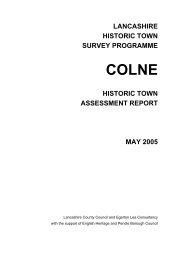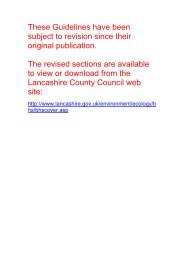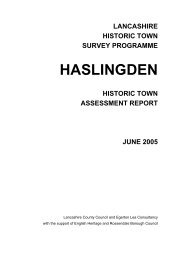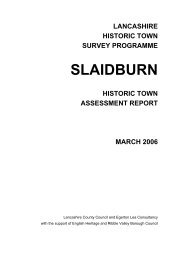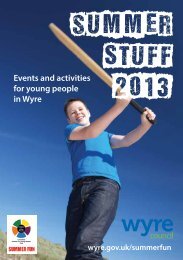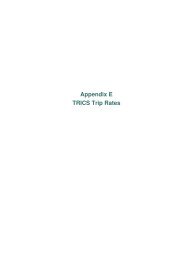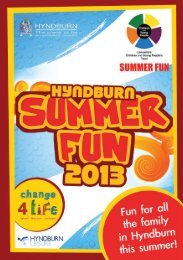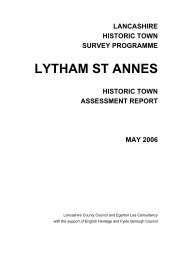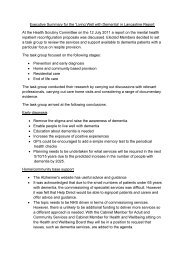HORNBY - Lancashire County Council
HORNBY - Lancashire County Council
HORNBY - Lancashire County Council
Create successful ePaper yourself
Turn your PDF publications into a flip-book with our unique Google optimized e-Paper software.
<strong>Lancashire</strong> Historic Town SurveyHornbySUMMARYThe <strong>Lancashire</strong> Historic Town Survey ProgrammeThis assessment report is a key end product of a survey of <strong>Lancashire</strong>’s historic townscarried out by the county’s Archaeology and Heritage Service, with the Egerton LeaConsultancy, between 2001 and 2006. The project, part of a national programme of workcoordinated by English Heritage, comprised a three-stage survey of the historical andarchaeological aspects of each of the thirty-three towns selected in <strong>Lancashire</strong>. Theprogramme aims to re-evaluate the national archaeological resource and to providecomprehensive, rigorous and consistent base-line information against which research,regeneration and land use planning objectives may be set. The programme has threeprincipal outputs: new data added to the <strong>Lancashire</strong> Sites & Monuments Record, acomprehensive report (submitted as this document) that contains background informationon the historical development and the current archaeological knowledge of each town, anda shorter Historic Environment Management Guidance report, which outlines strategies forconservation and enhancement.Hornby – Archaeological and Historical SummaryIn the Domesday Book Hornby is mentioned as a vill, as one of three adjacent manors heldby Ulf in 1066. In 1086 the manor was in the King’s hands, but soon after this it seems tohave been granted to the Montbegon family (Farrer and Brownbill 1912, 191). Of the threemanors held by Ulf, the most important may have been Melling as this was the parochialcentre and had a church, dedicated to St Wilfred (White 1986, 1). It may have been atMelling that Ulf had his caput. Alternatively, if Hornby was an existing Anglian vill renamedwhen passing into Danish lordship in the ninth century, it is plausible that it became thecentre of the lordship and that this was why it was the only settlement within the lordship tobe renamed. It may have been chosen precisely because it was not the centre of Anglianecclesiastical authority. Certainly, once the estate had passed to the Montbegon family itbecame the centre of the honor, even though as a township it remained subservient toMelling.The Montbegon honour is thought to have come into existence in the early twelfth century(Farrer 1902, 261). This family held the manor throughout the remainder of the twelfth andfor much of the thirteenth centuries, and is documented as having a castle at Hornby by1229 (Farrer and Brownbill 1912, 192). In 1279 the honour of Hornby passed by marriagefrom the Montbegons to the Nevill family. On the death of Geoffrey de Nevill in 1285 it wasrecorded that at Hornby there was a borough, a fulling mill, a corn mill and free courts(Farrer and Brownbill 1912, 192). On the death of his widow Margaret in 1319 similarattributes were noted, and the courts were described as the court baron and the boroughcourt (Farrer and Brownbill 1912, 193).The earliest reference to Hornby as a borough occurs in 1285 when it is recorded as suchwithin the Inquisitions Post Mortem of Geoffrey de Nevill (Higham 1992, 38). In 1319 thenumber of burgages was 47½ (Farrer and Brownbill 1912, 198), from which a populationfor the town of about 190 to 240, a total apparently similar to that in the early nineteenthcentury, might be surmised. This compares with nearby Warton, which had 44 burgages inthe late thirteenth century (Egerton Lea 2002), and with Clitheroe, which had 66 (White1996, 129). This makes Hornby seem a reasonably healthy medieval urban entity in<strong>Lancashire</strong> terms; however, the value of a burgage in Hornby was only fourpence perannum, compared with sixteen pence in Clitheroe (Higham 1992, 34).Title to a market and fair was granted at Hornby in 1292, although this representedchartered confirmation of rights that were argued to have already existed for a considerable© <strong>Lancashire</strong> <strong>County</strong> <strong>Council</strong> 2006 1



